Viral TikTok videos claim Putin shows Jesus as black in historic icons

Scores of viral videos on the social platform TikTok are claiming that Russian President Vladimir Putin recently opened up a vault revealing historic icons depicting Jesus, the Virgin Mary and his disciples as black. Fact-checkers from news agencies like Reuters and AFP say, however, that the claim is fabricated.
In one video shared on TikTok entitled, "Putin Reveals Truth 'Black Christ,'" the Russian president unveils a painting of a dark-skinned Jesus framed inside an ornate box.
An AFP report points out that the clip of Putin and the icon came from a visit he made to Russian troops stationed in Ukraine's annexed Kherson region in April 2023. During the visit, Putin presented them with a Russian Orthodox icon that belonged to a 19th-century Russian defense minister.
@baruch_baruk VLADIMIR PUTIN PUTTING THE TRUTH OUT #jesus#yeshua#facts#russia#truth#blackjesus#endtimes#fyp? Ameno - Loic D
Reuters reports that Russia's Orthodox Church celebrated Easter on April 16 that year, suggesting the gifting of the icon was a gesture marking the celebration of the holy day.
Another viral clip uses footage from Putin's 2023 New Year's Eve address, including an English voiceover and a caption alleging "Putin Proclaims Russia Under The Guidance Of 'Black Jesus.'"
"AFP’s archives also include a transcript of the video, which confirms that Putin makes no mention of Christ or religion in the speech but rather praises the Russian army and the country for being 'united' behind the Kremlin," the AFP report states.
Russian icons are described as paintings done on a wooden board, usually of a religious subject. According to The Russian American Company, in Sitka, Alaska, icons, which can be dated back to the 10th century, were also created in copper, brass and silver.
"Following strict guidelines of orthodoxy, these objects of fine religious art are essentially copies of depictions of saints and scenes such as the Virgin Mary that date to antiquity in the history of the church," the company noted.
An English translation of Father Vladimir Ivanov's book Russian Iconshighlights the works of great Russian iconographers such as Andrey Rublev, Dionisy and Simon Ushakov.
Many of the icons highlighted in the viral videos depict religious figures with dark skin, which is associated with more popular art, like the "Black Madonna."

According to Michael Duricy of the University of Dayton, there has been much controversy about the pigmentation of religious figures reflected in icons such as the "Black Madonna" and noted that researchers have suggested a number of possible reasons why some icons have darker skin.
Dark brown or black Madonnas could have been created to reflect the physiognomy and skin pigmentation matching that of the indigenous population where the art was created, he wrote.
Environmental facts such as the deterioration of lead-based pigments, the accumulation of smoke from the use of votive candles and the accumulation of grime over the ages could have also caused a darkening of the art, he added.
There were also cases where researchers could not provide an explanation for the pigmented icons beyond what was presented.
While some Western media personalities like Megyn Kelly have famously claimed that Jesus was a white man, the late iconic Evangelist Billy Graham argued several times in his sermons that Jesus was not.
"Don't you black people ever forget one thing. The man that helped Jesus carry that cross was a black man. And don't ever forget another thing. Jesus belongs to Africa as much as he does to Europe and Asia. He was born in that part of the world that touches Africa, Asia and Europe. Jesus was not a white man like me, nor was he as black as some of you," Graham explained in a clip from an old sermon.
"We don't know what the color of His skin [was], but it must have been a dark color like the people of His day because He was a man like them. Don't ever say it's a white man's religion or a black man's religion. It's a world religion. He belongs to the world."
He expressed similar sentiments during a 1973 sermon he preached in South Africa.
Contact: [email protected] Follow Leonardo Blair on Twitter: @leoblair Follow Leonardo Blair on Facebook: LeoBlairChristianPost






















